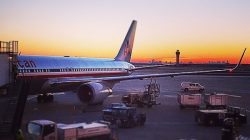US Department of Transportation rules in favor of United over Hawaiian
United Airlines has tentatively won its bid to secure a single pair of landing slots at Tokyo Haneda airport, which were vacated late last year by American. The decision by the US Department of Transportation to rule in United’s favor is not surprising given that of the four US carriers that compete in the North America to Asia Pacific market, Delta, American, United and Hawaiian, United only carrier that has not been granted access to Haneda airport since Japanese authorities began awarding routes to North American airlines in 2010. United outbid one other applicant for the Haneda slot, Hawaiian Airlines, which filed for rights to fly between HND and Kona, located on Hawaii’s Big Island.
The US DOT began accepting applications for the Haneda slot in October 2013 after American Airlines announced it was cancelling its daily roundtrip service from New York JFK to Tokyo Haneda. American’s decision was pragmatic given that it was unsuccessful in generating profits on this route, and the future outlook appeared bleak given that its allocated departure and arrival times into Haneda airport were ill-timed to attract lucrative business traffic. With a late-evening arrival into Tokyo on the inbound and an early morning departure on the return sector, connection opportunities to beyond markets in Asia were limited and a weakened Japanese economy created volatile market conditions to allow the route to survive alone off of O&D traffic without penalties.
American ultimately chose not to sit on its Haneda slot by moving the route to another one of its cornerstone hubs, nor did it replace lost capacity on New York – Tokyo by reinstating service to Tokyo Narita airport, which it once served from JFK until mid-2012. Rather, its joint-venture partner, Japan Airlines, will add a second daily service to JFK from Narita airport on a 787 at the end of March, which will help OneWorld maintain a competitive presence in the New York – Tokyo realm against Star Alliance and SkyTeam. Star Alliance JV partners ANA and United both offer 3 daily roundtrips between New York and Tokyo, with two services on ANA from JFK and one on United from Newark. Delta offers a single daily 747 service between JFK and Narita. Currently, no carrier offers nonstop service between New York and Haneda.
DOT contends United offers maximized benefits to US traveling public from SFO
Aside from being a new entrant at Haneda, United offers the most domestic US connections from its San Francisco hub over any other west coast gateway cities. Delta currently offers two daily roundtrips from Haneda to Seattle and Los Angeles, but does not classify either of these two airports as hubs within its domestic US network. While Delta has been adding a significant level of short-haul feeder flights into Seattle over the past few months, its peak weekly departures on Delta metal only amount to 1,154 frequencies for August 2014. At San Francisco, United’s peak weekly departures nearly total 4,300 flights.
When factoring in Delta’s codeshare agreement with Alaska, which allows the two carriers to provide feeder traffic on each others’ services out of Seattle, the connection opportunities appear a bit more balanced side-by-side to United at SFO. However, the future of that relationship remains somewhat murky given evolving dynamics between the two airlines, which has already seen a few codeshares on certain routes discontinued. Explanations from both parties have been vague at best.
In comparison, Hawaiian’s proposal from Kona relies exclusively on O&D traffic from Kona to Tokyo, which creates challenges when weighing this against United’s ability to connect Haneda to multiple North American points with a 1-stop connection in San Francisco. Hawaiian maintains that resting in its favor is the mere fact that Kona is Hawaii’s second busiest Origin and Destination market to Japan, and remains unserved today. Previously, Japan Airlines flew nonstop from Kona to Tokyo Narita from 1996 until 2010, when it had to discontinue the route due to financial challenges, and no other airline has since stepped in to pick up the slack.
Not surprisingly, Hawaiian has submitted an appeal, but likely for political purposes
As with previous rounds where landing slots at HND have been awarded among several competing bids, Hawaiian was given a 7-day window to appeal the decision by the US DOT, which it naturally chose to exploit even though its odds of reversing opinions are not promising. Hawaiian underscored how its success on its existing Honolulu to Haneda route has far outperformed its other US rival carriers on their Haneda flights, and that its Kona proposal opens a new nonstop market compared to an existing one (JAL operates a daily 787 service from SFO to HND).
While such facts are true, Hawaiian is also aided by the fact that Hawaii is the largest non-mainland inbound market to Japan from the US, and from an operations standpoint, the carrier benefits from shorter flying times to and from Tokyo to Honolulu, which compensates for unfavorable departure and arrival times.
Moreover, the appeal is likely designed to prolong the situation to make it more challenging for the winning bid to have extra lead-time to prepare for the inaugural flight. In any case, Hawaiian’s story is a tough sell given that, if it really saw business potential in commencing a nonstop Kona to Tokyo route, it could do so tomorrow by creating a link to Narita airport, where it would face fewer regulatory hurdles to obtain landing rights. Neither JAL nor ANA have attempted to reinstate nor start service between Tokyo and Kona, respectively, even though both airlines fly nonstop from both Tokyo airports to Honolulu. Even though Kona may lack nonstop connectivity to Asia, the Hawaii – Japan market is amply served as is over Honolulu.
Moreover, HA’s latest network expansion into the Asia-Pacific region has been categorized as overly-aggressive in recent years, and early results have fallen below shareholder expectations. Since 2010, Hawaiian has added 10 long-haul routes to Honolulu, but has seen passenger unit revenues fall several percentage points during recent operating periods, pinned largely on its new Asian flights. Fortunately, Hawaii has been keeping a close eye on these routes and some re-shuffling has taken place. The carrier suspended service to Manila in 2013 and will also be ending service to Taipei in April and Fukuoka in June. It also continues to fumble around with its frequencies to Seoul and New York JFK, indicating that these stations may have a way to go before reaching maturity and Hawaiian is intelligently adjusting capacity in the near-term.
As such, it’s likely a blessing in disguise that Hawaiian will probably lose the bid to United. Case examples by American, and to an extent, Delta, have proven that the Haneda flights are not exactly what they were projected out to be from the get-go. Even with a high-volume of O&D between Kona and Tokyo, connections are easily facilitated via 1-stop itineraries through Honolulu, and the threat of cannibalization, as well as the operating costs of basing a single long-haul aircraft at KOA, are both minimized by consolidating widebody operations at a single station in Honolulu.
Star Alliance power at Haneda will grow with the addition of United and Air Canada
Assuming United manages to succeed with the US DOT award after Hawaiian’s appeal is reviewed, Star Alliance carriers will effectively add three new transpacific services to North American hubs from Haneda airport, which will further leverage connection opportunities out of ANA’s base at HND. All Nippon is launching daily service to Vancouver at the end of March, and Air Canada plans to launch nonstop service from Toronto to Tokyo Haneda in July. A formal timeline for the launch of SFO-HND will likely be announced shortly once the US DOT makes a final decision on the awarding.
The decision, initially expected to be made in early December, was likely also delayed to allow the launch to take place during a more favorable window for the winning carrier. Inaugurating a flight during the summer month allows seats to be filled much more easily than during the slower winter period. Moreover, United also has over 50 of the Boeing 787 Dreamliner variants on order, with 5 slated for delivery this year. It is possible that the launch date will coordinate nicely with the opportunity to replace the 777-200ER initially proposed to be used on the route with a 787-800, which may be more economically viable over the long run.




